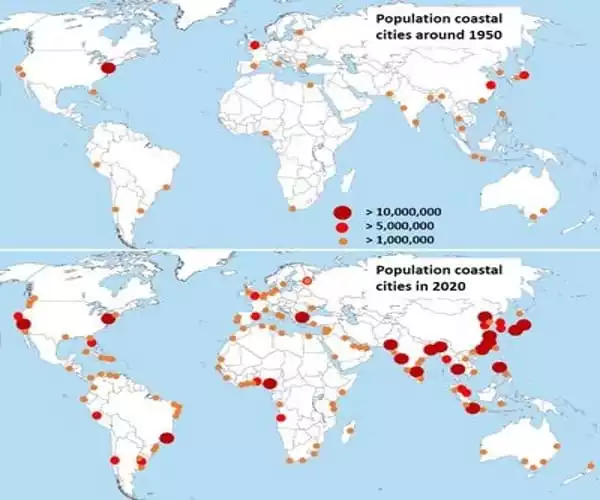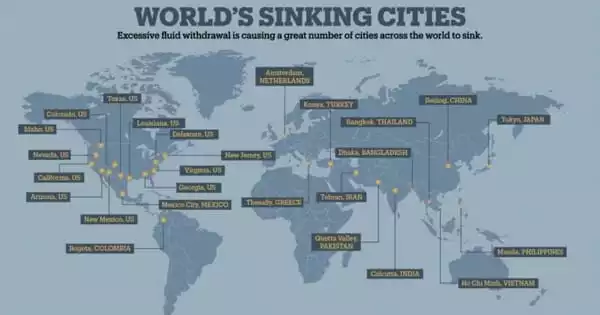Sinking cities are urban areas that are on the verge of disappearing as a result of rapidly changing surroundings. The combined consequences of climate change, ground subsidence, and increased urbanization are the most significant contributors to many cities’ becoming unlivable. Many of the world’s largest and fastest developing cities are built along rivers and coasts, making them vulnerable to natural disasters. As governments continue to invest in people, assets, and infrastructure in these cities, the potential for loss in these locations grows. Sinking cities must face significant obstacles in order to adequately adapt to today’s dynamic environmental situation.
Satellite data show that coastal communities throughout the world are sinking by several centimeters each year on average. Researchers find in Geophysical Research Letters that the combination of subsiding land and rising seas puts these coastal locations at higher danger of flooding than previously assumed.
Matt Wei, an earth scientist at the University of Rhode Island in Narragansett, and his colleagues investigated 99 coastal cities across six continents. “We sought to strike a balance between population and physical location,” he explains. While subsidence has previously been observed in cities, past research has tended to focus on a single city or region. This inquiry is unique, according to Wei. “It’s one of the first to make extensive use of data with worldwide coverage.”
These cities are being slammed with a double whammy: at the same time as sea levels are rising owing to climate change, the ground is sinking. “Understanding that aspect of the situation is critical.
Solano-Rojas
The growing physical risks to many coastal cities stem from a combination of factors relating to rapid urbanization, climate change, and land subsidence. Many of these natural hazards are largely anthropogenic in origin. In many cases, the fundamental aspects that lead to sinking cities become tightly interwoven, and over time, are increasingly difficult to resolve.
Wei and his colleagues relied on data provided primarily by a pair of European satellites between 2015 and 2020. Onboard instruments send microwave signals toward Earth and record the waves that bounce back. The scientists measured the height of the ground with millimeter accuracy by monitoring the timing and intensity of those reflected waves. Because each satellite passes over the same area of the planet every 12 days, the researchers were able to track how the ground changed over time.
The researchers discovered that Asian cities with the highest subsidence rates — up to five centimeters per year — are predominantly in Tianjin, China; Karachi, Pakistan; and Manila, Philippines. Furthermore, one-third, or 34, of the cities studied are sinking by more than a centimeter every year in some regions.

This is a concerning tendency, according to Daro Solano-Rojas, an earth scientist at the National Autonomous University of Mexico in Mexico City who was not engaged in the study. These cities are being slammed with a double whammy: at the same time as sea levels are rising owing to climate change, the ground is sinking. “Understanding that aspect of the situation is critical,” Solano-Rojas says.
Wei and his colleagues believe that individuals are primarily to blame for the subsidence. When the researchers examined Google Earth data of quickly sinking zones within cities, they found predominantly residential or commercial areas. The researchers decided that this is a red flag that the culprit is groundwater exploitation. As water is drained out of aquifers, landscapes settle.
But there is reason to be optimistic. In the past, Jakarta, Indonesia, for example, was sinking at a rate of roughly 30 cm each year on average. However, subsidence in that area and elsewhere has decreased, probably as a result of new legislative rules restricting groundwater exploitation.
Throughout the twenty-first century, as these cities continued to grow, freshwater became an ever more precious resource. Due to the dense populations along river deltas, industrial development, and relaxed or no environmental protections, river waters often became polluted. This has become an ever more common phenomenon in coastal mega-cities, particularly in Asia. Many cities are unable to afford costly water treatment systems and are forced to rely heavily on groundwater.
Voids are formed beneath the earth when groundwater is withdrawn from subterranean aquifers faster than it can recharge. The soil compresses and the land begins to subside as the ground is loaded, most typically through increased development. Subsidence can occur quickly, as in many coastal plains, or slowly, as in regions with extensive bedrock.
















